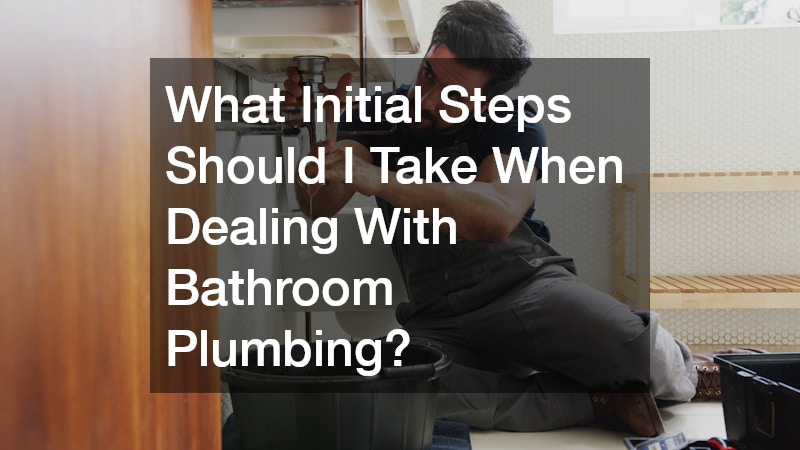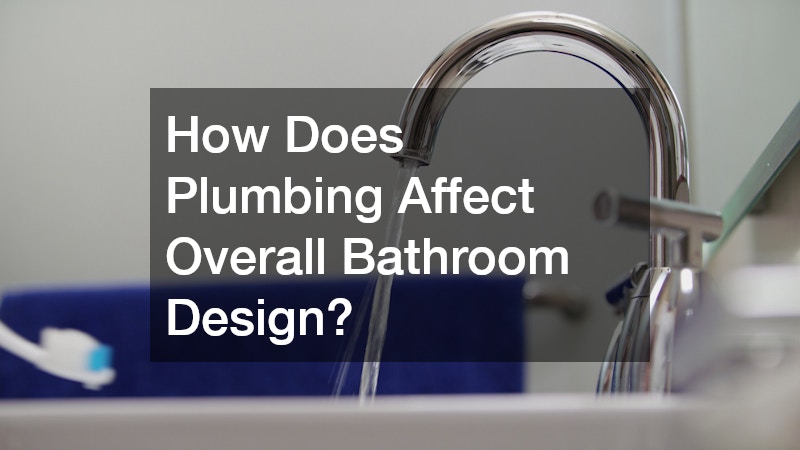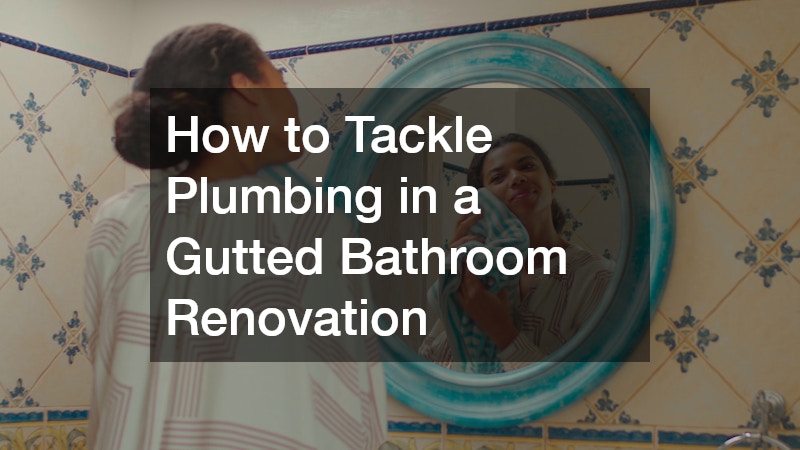Renovating a gutted bathroom can feel both exciting and overwhelming. Stripped down to its bare bones, a gutted bathroom presents a unique opportunity to reimagine the space entirely — and at the heart of this transformation lies the plumbing. Every fixture, from the sink to the shower, relies on a properly planned and executed plumbing system.
A gutted bathroom gives you direct access to the plumbing behind the walls and under the floors, making it the perfect time to upgrade pipes, install a quality water filtration system, and address any hidden problems like leaks or old materials. But it also comes with challenges. Knowing where pipes can and should go, choosing the right materials, and coordinating with a plumber or plumbing company are all essential.
In this guide, we’ll walk you through everything you need to know to tackle the plumbing side of your gutted bathroom renovation. You’ll learn how to assess your existing system, make smart choices about materials and fixtures, avoid common mistakes, and work effectively with professionals like local plumbers and drain cleaning contractors when necessary.
What Initial Steps Should I Take When Dealing With Bathroom Plumbing?

Assessing the Current Plumbing Layout
Before making any changes, examine your current plumbing layout. If you’ve hired a local plumber, they can help identify which pipes are in good condition and which need replacing. Look at how the pipes are routed and consider whether you want to keep the same layout or change it to suit your new design.
Understanding Building Codes and Regulations
Each city or municipality has its own plumbing codes that dictate everything from pipe materials to fixture placement. Consulting a plumbing company or local plumbing service is the best way to ensure your gutted bathroom meets these requirements. Getting it wrong can lead to fines or costly repairs later.
Planning Your New Plumbing Design
Work with your plumber or plumbing services provider to map out a new plumbing design that suits your needs and stays within code. This is also the stage to think about adding upgrades like a quality water filtration system or improved drainage.
How Do I Choose the Right Pipes for My Bathroom?
Comparing Pipe Materials: PVC, Copper, and PEX
In a gutted bathroom, you’re free to replace old, corroded pipes with more reliable options. PVC is cost-effective and great for drainage, copper is durable and traditional, and PEX is flexible and easy to install — ideal if you’re working with drain cleaning contractors who need to navigate tricky spaces.
Understanding the Pros and Cons of Each Pipe Type
PVC is affordable but not suited for hot water supply. Copper lasts long but can be expensive. PEX is versatile and resistant to freezing but may not be allowed everywhere.
Deciding on Pipe Size and Fittings
A plumber can help you determine the right pipe sizes for water supply and drainage to ensure good water pressure and efficient flow — critical for fixtures like bathtubs and showers.
What Are the Key Considerations When Installing New Drainage Systems?
Designing an Effective Drainage Layout
A good drainage system prevents water from pooling and reduces the risk of mold or water damage. Drain cleaning contractors can help plan a layout that minimizes clogs and maximizes efficiency in your gutted bathroom.
Ensuring Proper Ventilation for Drainage
Plumbing vents allow sewer gases to escape and keep drains functioning properly. Make sure vents are included in your drainage design to avoid future problems.
Installing Floor Drains and Shower Drains
Modern bathrooms often feature walk-in showers with linear drains. Installing these correctly is crucial, so working with experienced plumbers or drain cleaning professionals is recommended.
How Do I Handle Plumbing for Bathtubs and Showers?

Setting Up Shower Valves and Supplies
Setting up plumbing for bathtubs and showers is one of the most critical parts of a gutted bathroom renovation because it directly affects both functionality and comfort. Installing shower valves requires precision to ensure that water flow and temperature are properly regulated. A plumbing company or experienced local plumber can help you choose the correct type of valve and position it at the most convenient height for all users, which is especially important if you’re incorporating accessibility features or custom designs.
Installing Bathtub Plumbing
For bathtub plumbing, planning adequate support is essential. A freestanding tub, for example, often requires additional bracing, while a built-in tub may need proper framing and sealing to prevent water damage. If you’re reusing an older tub, don’t forget to check for cracks or leaks and hire someone skilled in bathtub repair if needed.
Choosing Fixtures and Accessories
When it comes to fixtures and accessories, such as rain showerheads, handheld sprayers, or freestanding tub fillers, making sure they are compatible with your plumbing system is vital. This is where the advice of drain cleaning contractors and plumbing services professionals can make a big difference. They can ensure that water pressure remains strong, drainage is adequate, and everything is installed securely.
What Should I Consider When Installing a Toilet?
Deciding on the Toilet Location
Toilets may seem straightforward, but in a gutted bathroom renovation, their placement and installation require thoughtful planning. Your toilet’s position usually depends on the existing waste line since moving the flange can be labor-intensive and costly. However, if you’re changing the layout of your gutted bathroom, it may be worth relocating the toilet for better use of space. Consulting plumbing services professionals early in the process ensures you avoid expensive mistakes and optimize both form and function.
Understanding Rough-In Dimensions
Understanding rough-in dimensions is equally important. Most toilets are designed for a 12-inch rough-in, measured from the wall to the center of the drainpipe, but there are also 10- and 14-inch models available. Accurate measurement ensures that the toilet fits properly without requiring additional modifications.
Installing Toilet Supply Lines
Installing toilet supply lines might seem like a small detail, but it’s essential for reliable performance. High-quality supply lines help prevent leaks and water damage. A local plumber or local plumbing service can handle this efficiently, making sure that fittings are secure and connections are tight, reducing the risk of future problems.
How Can I Efficiently Set Up a Bathroom Sink?
Choosing the Right Sink Type
A bathroom sink is often the focal point of a gutted bathroom, so it’s worth spending time choosing the right type and ensuring it’s installed properly. Vessel sinks, pedestal sinks, and undermount sinks all have different plumbing requirements and spatial considerations. Think about how much storage you want, how high the sink should sit, and how it will complement the rest of your bathroom. A plumber can advise you on the best choice for your needs while keeping the plumbing practical and efficient.
Installing Sink Faucets and Fixtures
Installing sink faucets and fixtures may look simple, but they must be done with care to avoid leaks and misalignments. Even minor mistakes during installation can lead to water damage or poor water flow. Local plumbing services specialize in these tasks and can complete them quickly while ensuring proper alignment and sealing.
Connecting Sink Drainage
Finally, connecting sink drainage is crucial for a fully functional bathroom. Drain cleaning contractors can help set up or inspect the drainpipes to make sure everything flows properly and complies with local codes. Taking these extra steps ensures your gutted bathroom’s sink is both beautiful and reliable.
What Are the Best Practices for Water Heating Systems in Bathrooms?

Deciding Between Tankless and Tank Water Heaters
When renovating a gutted bathroom, it’s a perfect opportunity to assess your water heating system and decide if an upgrade is in order. Choosing between a tankless water heater and a traditional tank model depends on your household’s needs and your budget. Tankless heaters save space and energy but often come with higher upfront costs and may require adjustments to your plumbing system.
Installing and Maintaining a Water Heating System
Installing and maintaining a water heating system is best left to water heater services professionals. They can evaluate your home’s existing infrastructure, recommend the right unit, and install it safely. Proper installation helps ensure consistent water temperature and flow to your bathroom fixtures.
Ensuring Energy Efficiency With Water Heaters
Ensuring energy efficiency with water heaters is another important factor. Adding insulation, setting the thermostat to an optimal temperature, or upgrading to an ENERGY STAR®-rated unit can save you money on your energy bills over time. Whether you’re working with a plumber or a plumbing company, these improvements can make your gutted bathroom more comfortable and cost-effective in the long run.
How Can I Prevent Common Plumbing Issues in the Future?
Tips for Maintaining Pipes and Fixtures
A gutted bathroom renovation gives you the chance to build in preventative measures that can save time and money down the road. Regular maintenance by plumbers or drain cleaning contractors is one of the best ways to prevent clogs, corrosion, and leaks. They can also spot potential issues before they become serious problems.
Planning for Easy Access and Repairs
Planning for easy access and repairs during your remodel is wise. For example, adding access panels behind tubs or under sinks can make it much easier to reach plumbing if you need to fix a leak or replace a fixture later. This simple step can save you significant hassle and expense.
Avoiding Common Installation Mistakes
Avoiding common installation mistakes — like failing to vent drains properly, using the wrong pipe materials, or skipping slope calculations in drainage lines — is critical. Working with a professional plumbing company or local plumbing service ensures that your gutted bathroom’s plumbing is done right the first time.
What Safety Precautions Should I Take During Installation?
Understanding Plumbing Safety Standards
Plumbing work, especially in a gutted bathroom, comes with its own set of risks. Familiarizing yourself with plumbing safety standards is the first step. Wearing gloves, goggles, and protective footwear is essential, even for minor tasks. If you’re unsure about safety protocols, consult a plumber to handle more complex jobs.
Identifying and Managing Potential Hazards
Identifying and managing potential hazards is crucial. Water and electricity don’t mix, and old building materials can sometimes contain harmful substances like lead or asbestos. Local plumbing service providers are trained to handle these risks safely, ensuring that your renovation goes smoothly without endangering anyone.
Using the Right Tools and Equipment Safely
Using the right tools and equipment safely is also important. Even basic plumbing tools can cause injury if used improperly. If you decide to tackle any part of your gutted bathroom’s plumbing yourself, take the time to learn how to use each tool correctly. Otherwise, leave it to experienced plumbers or plumbing services professionals who already have the expertise and equipment.
How Does Plumbing Affect Overall Bathroom Design?

Integrating Plumbing With Aesthetic Design
Plumbing isn’t just functional — it’s also a key factor in how your gutted bathroom looks and feels. Integrating plumbing with aesthetic design allows you to achieve a seamless balance between style and practicality. Working with a plumber can help you hide pipes where possible or even make them part of the design if you’re going for an industrial look.
Maximizing Space With Efficient Layouts
Maximizing space with efficient layouts is another benefit of good plumbing planning. By placing fixtures strategically and using space-saving technologies, even a small gutted bathroom can feel spacious and comfortable. This can also make routine maintenance by plumbers and drain cleaning contractors easier down the line.
Incorporating Modern Plumbing Technologies
Incorporating modern plumbing technologies — like touchless faucets, built-in water filtration systems, or low-flow fixtures — enhances your bathroom’s functionality and efficiency. These upgrades not only save water and energy but also add a touch of luxury and convenience to your everyday routine.
Conclusion
Plumbing is the backbone of any gutted bathroom renovation. Starting with a completely stripped-down space gives you the chance to upgrade not just the look of your bathroom but its functionality, reliability, and efficiency.
Throughout this guide, we’ve explored the key steps to take — from assessing your current plumbing layout and choosing the right materials, to working with professionals like plumbers, drain cleaning contractors, and water heater services experts. We also covered how to handle specific fixtures like sinks, toilets, bathtubs, and showers while ensuring proper drainage and ventilation.
Don’t forget the importance of planning for maintenance and leaving room for future repairs. Using a quality water filtration system, hiring skilled local plumbing service providers, and being mindful of safety standards are all ways to ensure your gutted bathroom remains a functional and beautiful space for years to come.
When in doubt, don’t hesitate to consult a plumbing company or local plumber. Their expertise can save you time, money, and headaches down the road. With thoughtful planning and the right help, your gutted bathroom can transform into a sanctuary of comfort and style — built on a solid foundation of excellent plumbing.


